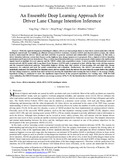- CERES Home
- →
- Cranfield Defence and Security
- →
- Staff publications (CDS)
- →
- View Item
JavaScript is disabled for your browser. Some features of this site may not work without it.
| dc.contributor.author | Xing, Yang | |
| dc.contributor.author | Lv, Chen | |
| dc.contributor.author | Wang, Huaji | |
| dc.contributor.author | Cao, Dongpu | |
| dc.contributor.author | Velenis, Efstathios | |
| dc.date.accessioned | 2020-07-16T16:08:02Z | |
| dc.date.available | 2020-07-16T16:08:02Z | |
| dc.date.issued | 2020-04-23 | |
| dc.identifier.citation | Xing Y, Lv C, Wang H, et al., (2020) An ensemble deep learning approach for driver lane change intention inference. Transportation Research Part C: Emerging Technologies, Volume 115, June 2020, Article number 102615 | en_UK |
| dc.identifier.issn | 0968-090X | |
| dc.identifier.uri | https://doi.org/10.1016/j.trc.2020.102615 | |
| dc.identifier.uri | http://dspace.lib.cranfield.ac.uk/handle/1826/15560 | |
| dc.description.abstract | With the rapid development of intelligent vehicles, drivers are increasingly likely to share their control authorities with the intelligent control unit. For building an efficient Advanced Driver Assistance Systems (ADAS) and shared-control systems, the vehicle needs to understand the drivers’ intent and their activities to generate assistant and collaborative control strategies. In this study, a driver intention inference system that focuses on the highway lane change maneuvers is proposed. First, a high-level driver intention mechanism and framework are introduced. Then, a vision-based intention inference system is proposed, which captures the multi-modal signals based on multiple low-cost cameras and the VBOX vehicle data acquisition system. A novel ensemble bi-directional recurrent neural network (RNN) model with Long Short-Term Memory (LSTM) units is proposed to deal with the time-series driving sequence and the temporal behavioral patterns. Naturalistic highway driving data that consists of lane-keeping, left and right lane change maneuvers are collected and used for model construction and evaluation. Furthermore, the driver's pre-maneuver activities are statistically analyzed. It is found that for situation-aware, drivers usually check the mirrors for more than six seconds before they initiate the lane change maneuver, and the time interval between steering the handwheel and crossing the lane is about 2 s on average. Finally, hypothesis testing is conducted to show the significant improvement of the proposed algorithm over existing ones. With five-fold cross-validation, the EBiLSTM model achieves an average accuracy of 96.1% for the intention that is inferred 0.5 s before the maneuver starts. | en_UK |
| dc.language.iso | en | en_UK |
| dc.publisher | Elsevier | en_UK |
| dc.rights | Attribution-NonCommercial-NoDerivatives 4.0 International | * |
| dc.rights.uri | http://creativecommons.org/licenses/by-nc-nd/4.0/ | * |
| dc.subject | Driver intention | en_UK |
| dc.subject | ADAS | en_UK |
| dc.subject | RNN | en_UK |
| dc.subject | LSTM | en_UK |
| dc.subject | Intelligent vehicle | en_UK |
| dc.title | An ensemble deep learning approach for driver lane change intention inference | en_UK |
| dc.type | Article | en_UK |
| dc.identifier.cris | 27239211 | |
| dc.date.freetoread | 2021-04-24 |
Files in this item
The following license files are associated with this item:
This item appears in the following Collection(s)
-
Staff publications (CDS) [1209]

